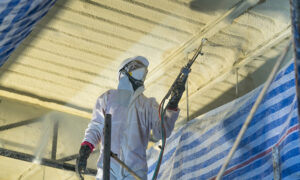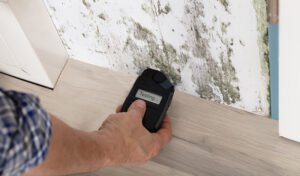Air barriers are essential to keeping commercial buildings properly insulated and structurally sound. However, even with a proper system, some air barriers still have penetrations that can leave the structure vulnerable. It’s important to seal these penetrations to avoid damage and minimize costs.
What Are Air Barriers?
Air barriers are insulation systems made from materials that control or block air movement through structural cavities. They prevent air from flowing in and out between indoor and outdoor spaces. These barriers can prevent the loss of cool and hot air. Air barriers also prevent unwanted airborne substances from infiltrating commercial buildings.
Air barriers come in many different forms. Here are some examples of materials used to construct an air barrier to protect commercial buildings:
 Poured concrete
Poured concrete- Glass
- Metal
- Spray polyurethane foam
- Fastened building wraps
- Non-insulating board stock
- Insulating board stock
- Fluid-applied membrane air barrier
- Adhesive membranes
Regardless of the material, air barrier insulation structures are designed to be impermeable to airflow. They are also continuous over the entire enclosure and should be able to withstand various forces. Moreover, good air barriers are durable enough to last the lifetime of the commercial building.
Interior and Exterior Air Barriers
There are two types of air barriers: interior and exterior. Interior air barriers manage the airflow between the structure’s interior air and the attic or wall cavity. This prevents moist air from penetrating the wall during hot seasons. It also limits losses of conviction in the walls. Meanwhile, exterior air barriers manage the airflow of the outside air into the wall cavity and attic. Similarly, it prevents the outdoor air’s moisture from penetrating the walls during cooling seasons. It also limits wind-washing.
Both the interior and exterior air barriers are important to maintaining a building’s structural integrity and promoting energy efficiency. Installing only one of the two types can be a waste of money as it may negate the advantages of the one installed.
Air Barrier vs Vapor Barrier
It’s important to distinguish between air barriers and vapor barriers, as the former does not prevent vapor from infiltrating the structure. That’s because an air barrier is mainly created to control airflow and prevent leakage. On the other hand, vapor barriers or retarders control or limit the movement of water vapor through materials. They are often installed on the warmer part of building insulation structures. Vapor barriers are installed on the exterior in warm climates but on the interior in cold climates.
In addition, vapor barriers are different in that they do not have to be hole-free or continuous. Hence, they often don’t need to be sealed or lapped, even when there are penetrations. Here are some examples of materials used to create vapor barriers:
- Medium-density spray polyurethane foam
- Insulating board stock
- Fastened sheet-material
- Fluid-applied materials
- Adhesive membranes
What Are Air Barrier Penetrations?
Air barriers must be impenetrable for them to control airflow. However, commercial buildings do not only need walls to function properly. A building will also need plenty of other systems like plumbing and electrical wiring to be useful. These systems often must go through the structure’s air barriers to operate. Here are some examples of typical air barrier penetrations:
- Vertical wiring or conduits
- Rain shedding assemblies
- Plumbing pipes and vents
- Electric boxes and recessed fixtures
- Interior soffit
Most air barriers need supplemental sealing to ensure these penetrations don’t compromise air control. Moreover, the supplemental sealants should not interfere with the performance of these various other systems. For example, the sealing shouldn’t hinder rainwater management assemblies from properly draining water.
Why Is it Important to Seal Air Barrier Penetrations?
Installing air barriers is not enough to maintain a structure. Commercial building owners must also consider the air barrier system’s penetrations to insulate and control airflow fully. Why is it important to seal air barrier penetrations? Here are the main benefits.
1. Reduces Hot or Cool Air Leakage
The air sealing of wall penetrations can significantly reduce hot or cold air leakage. This allows the HVAC systems to perform well and regulate the temperature and air quality. It also makes the overall environment more comfortable for commercial building users. This is especially crucial for commercial buildings that accommodate guests and customers, like malls, hotels, and retail buildings.
2. Limits Energy Consumption
Sealing plays an important role in limiting energy consumption and promoting energy efficiency. That’s because even a few air leaks can alter the building’s temperature and air quality. Buildings without penetration sealing will need larger HVAC equipment to compensate for the air leakage. Moreover, HVAC systems must run longer and harder to cool or heat the air consistently. This is especially noticeable during hot summers and cold winters when temperature control relies heavily on the building’s HVAC systems.
 3. Prevents Moisture Damage
3. Prevents Moisture Damage
The air sealing of penetrations can prevent water damage. That’s because water vapor comes in quite easily through air leakage. This unwanted moisture can lead to roof leaks and water-damaged walls, eventually compromising the building’s structural integrity. As a result, the building owner will need to pay a hefty sum in repair costs.
4. Protects Against Pollutants and Allergens
Sealing air barrier penetrations can promote better air quality overall inside the building. That’s because allergens and pollutants from the outside cannot leak inward. This protects the building’s structural integrity and reduces the risk of disease or allergies for those inside the building.
5. Lowers Maintenance and Repair Costs
Controlling airflow, reducing energy consumption, and preventing moisture damage can all save building owners a lot of money in maintenance and repair costs. It also prolongs the lifespan of various building components. Thus, the need for replacements and reconstruction will come much later.
Creating Airtight Air Barriers
Commercial building owners should not solely focus on installing air barriers to control airflow. It’s also vital to seal the barrier’s various penetrations to make sure the building is airtight. This allows the building to stay comfortable and structurally sound. It also lowers utility, repairs, and maintenance costs.
Maintenance Specialists Inc. provides the best maintenance services for commercial buildings in the industry. Don’t hesitate to call us at 704.405.6000 or contact us online to learn more about how we can help you!
RELATED ARTICLES:
- How Valuable Is A Means Of Egress Maintenance Service?
- What Is Soft Service Facility Management?
- The Phases Of Post Construction Cleaning And Why Hiring The Pros Is Better

